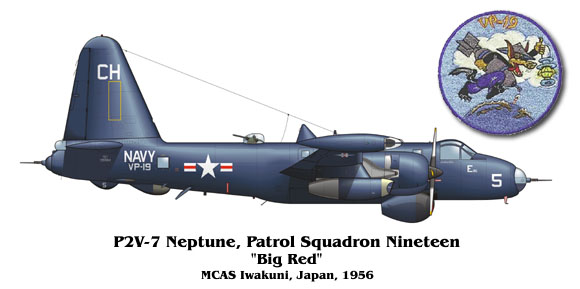
VP-19 "Big Red" began its association with the Neptune when it transitioned from the PB4Y-2 to the P2V-2/3 in July of 1952. The following year VP-19 transitioned again to the P2V-5 and by August 1955 "Big Red" traded in their model fives for the new P2V-7. During the squadron's deployment in 1956, several of the squadron's aircraft were unusually configured with nose and tail turrets including the subject of this months profile. This arrangement seems to have been unique to VP-19.





Photos courtesy Lockheed P2V Neptune Research Project Pages
In 1955 Buaer 135584 was delivered to VP-19 with the production standard MAD tail and Observation nose. Sometime between May 1955 and May 1958, 135584 acquired the Aero 9B nose turret and the Aero 11A-1 tail turret. 135584 later returned to Burbank in November 1958 and was passed on to VP-23 in 1959. This particular aircraft was eventually re-configured to the production standard and finished out its operational life with NAS Willow Grove. 135576 was also similarly configured as late as May 1957 with nose and tail turrets in place. Any additional information about these modifications and their purpose or other squadrons similarly configured, would be most welcome!
P2V Neptune Historical Research


135584 as originally delivered to VP-19 in 1955. Aircraft was configured with MAD tail and Observation nose and carried the pre 1957 "CH" tail code. The oversized buaer was not applied to the tail during this time period. Aircraft was overall sea blue.


The same aircraft as it appeared in 1958 at NAS Moffett Field. While the aircraft still wears the sea blue patrol plane scheme, the post 1957 "PE" tail codes and the oversized Buaer numbers on the tail have been applied. Guns were often removed from the turrets when deployed state side.

135584 during the twilight of it's service life. 135584 ended its days at NAS Willow Grove before going to Davis-Monthan and finally scrapped. As evidenced by the photo taken in November 1967, this aircraft reverted back to the MAD/Observation nose configuration.
VP-19 History - Naval Historical Center

|
